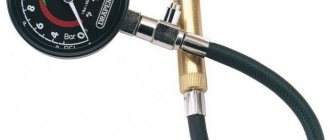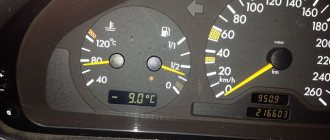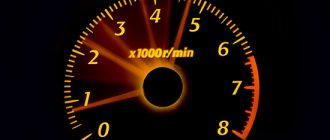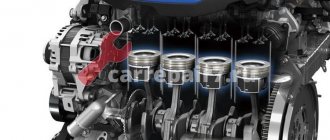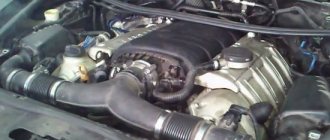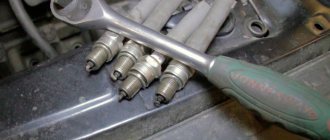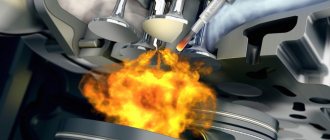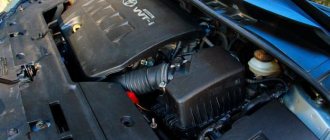There are many reasons for this. But among them we can distinguish those that occur in almost 90% of cases.
First of all, it is necessary to exclude the influence of low temperatures. In cold weather, the car may not start due to insufficient battery power, as well as due to the use of summer oil, which becomes very thick (these are two main reasons, but there may be others: for example, bad spark plugs or a clogged fuel pump).
Installing an automatic engine warm-up system can help here. If problems with operation occur even at positive temperatures, then it is necessary to continue troubleshooting.
- Quite often, poor car starting is due to low fuel quality. In this case, the injectors and fuel filters may become clogged.
- The air filter may also become dirty. Replacing it is quite simple and completely solves the problem.
- On diesel engines, poor starting can be caused by incorrectly selected fuel. Such motors require a seasonal change in types of diesel fuel (“summer”, as well as “winter” or “arctic” - for especially cold regions).
- Low compression in the combustion chamber. A decrease in pressure can occur due to engine wear (during its operation, the gaps are closed by an oil film, while when they cool, they reappear), as well as due to incorrect installation of the timing belt.
- Another reason why an injection engine has difficulty starting when cold is the failure of the sensors (DPRV, DPS, DMRV).
- It was already written above that problems with starting in winter can arise due to bad spark plugs or a clogged fuel pump. It is worth noting that these problems can also arise at positive temperatures.
- Sometimes poor starting is caused by a lack or, on the contrary, an excess of fuel when supplied. On injection engines, spark plugs may flood in the winter (this problem usually occurs in used cars). In this case, you need to unscrew them and dry them.
- A fairly common reason why a cold engine does not start well is contamination of the throttle valve. In this case, it does not open completely, which is why the motor does not work properly.
- There is a fault in the electrical circuit. If the battery has a charge, but there is no spark at the spark plugs, you need to make sure that the high-voltage wires are intact, as well as the functionality of the ignition coil (checked with a multimeter). True, with such a breakdown, starting problems will arise not only on a cold engine.
- Sometimes the cause of poor starting is a dirty idle air valve. After cleaning it, problems with engine operation should disappear.
Important! If, when you try to start the engine, smoke comes out of the exhaust pipe and the car does not start, it means that fuel is being supplied, but it is not ignited.
Identifying and eliminating engine starting problems
In most cases, problems can be identified and fixed without much difficulty. So, a sign of clogged fuel filters will be difficulties starting the engine (it may stall at idle), a decrease in power, and also the car jerking during inclines.
It is worth noting that such “symptoms” can also be the result of other faults, such as wiring problems or faulty spark plugs. In this case, it is necessary to urgently replace the filters. If this is not done in time, the motor may fail.
Fuel supply can be checked by unscrewing the spark plugs. If they are filled with gasoline, or, on the contrary, are completely dry, then it is necessary to check the sensors or adjust the carburetor.
Another problem, a sign of which may be that the engine does not start when cold, is clogged injectors. In this case, the car loses dynamics when accelerating sharply, twitches and reacts poorly to pressing the gas pedal. In addition, muffled high-frequency noises may be heard coming from the cylinder block.
If the injectors are indeed coated with deposits, they need to be cleaned. You can do this yourself. There are several main ways to restore this part:
- The first cleaning method is rather preventive. It consists of adding special additives to the fuel that help get rid of deposits on the injector. However, many motorists try to use this method as little as possible: it is believed that additives can further worsen engine performance.
- Some experts recommend periodically turning the engine up to high speeds. After several kilometers at a speed of 100-110 km/h, engine performance should improve somewhat.
- If the injectors are seriously dirty, you will have to clean them manually. To do this, you need to disassemble the injector. After this, the parts are washed with high-quality fuel without impurities or kerosene and blown with compressed air.
- There are two more ways to clean injectors. They guarantee almost 100% results, but to implement them you need to use professional equipment and have certain skills. Therefore, it is better to contact a service center here. In the first case, the parts are exposed to ultrasound, which destroys all plaque. In the second, a special liquid and a device are used that is connected to the fuel receiver. After the engine has been idling for some time, the injector will be cleaned.
Important! You should not take action without making sure that a specific node is indeed the cause of the poor startup. This is especially true for complex work, the incorrect execution of which can lead to even more serious damage. If in doubt, it is better to turn to professionals.
In conclusion, it is worth adding that it is better to look for the reasons for poor starting of a cold engine as they become more complex. So, you should not check the timing belt or engine compression without making sure there is fuel in the gas tank and a charge in the battery.
By methodically considering all possible fault options, you can get to the true cause of a poor start, and, in most cases, fix it yourself.
Why does my car start poorly when cold? List of reasons
Why is my car hard to start when cold? This question can often arise among drivers and car owners who just recently drove the car, and everything was fine, it sat, cooled down and does not start or starts with great difficulty.
It should be noted that there are no problems when it’s hot. Many modern cars have heating systems installed before starting, however, this does not always save.
When such problems arise, and often this happens in the morning, in front of the car with the hood open, fuss begins to warm it up and subsequent frantic attempts to start it. But, probably, every person who has a car wants to get into it, start it and drive, and not wake up with thoughts of whether it will start or not. In this article we will look into what causes the power unit to start poorly when cold.
Why is it difficult to start a car when it’s cold? It is impossible to answer this question unambiguously and accurately. The following can be taken as the main axioms of the reasons: there is nothing to ignite in the combustion chamber and there is nothing to ignite in the combustion chamber.
Of these two principles, all the rest will be only causes of a given effect. So, now let's look at each axiom separately. The concept of nothing to ignite means not only the absence of fuel, but also poor quality of its supply to the combustion chamber: too little fuel and too much fuel.
An indicator of the first reason can be a candle. We unscrew it (after turning it with the starter) from the engine and look at it: if it is flooded with gasoline, it means it is overflowing and we look further point by point, if it is dry, fuel is not delivered and again we look for the reason point by point. Also check the candle by smell - if it doesn’t smell like gasoline at all, then the cause has been found.
Let's move on to the second reason. If we checked the fuel supply and everything is as it should be, we look for the cause in the ignition device:
- First of all, we check the battery. It may be too discharged, and the starter barely turns or at different speeds;
- Malfunctions in the ignition distributor. At the same time, the machine does not try to “grab”, so to speak;
- Fracture or piercing of a high-voltage wire. In a shaded area when starting the engine, you can see a glow on these wires;
- The ignition coil is faulty. You can check with a multimeter (if there is only one ignition coil);
- The simplest thing is that the spark plugs have failed.
Naturally, when first considering the problem of cold starting, you should not look for the problem in the fuel pump, disassemble the injector, go to the timing belt, or open the cylinder block. As a rule, such reasons are rare, but they do occur, so you still need to start with the simpler ones and gradually move closer to the more complex ones.
In the article we tried to answer the question as fully as possible: why is it difficult for a car to start when it’s cold? If these problems occur, try leaving the car in cold air less often or warm it up over time.
Today you can find special devices that will maintain the engine temperature constant or turn on and warm it up at certain intervals. For example, the Tomahawk copes with this task.
The main reasons for poor cold starting
There are several main reasons why starting a cold engine will be difficult or even impossible. To understand the cause of the malfunction, it is necessary to conduct a thorough diagnosis and localize the breakdown. First you need to check the battery, it is possible that it is completely discharged. Next, you need to check that the starter works and rotates the engine at the same speed. If you refuel with low-quality gasoline, this can also lead to the fact that your car’s engine will be difficult to start when cold.
Problems with fuel supply.
Problems with cold starting appear when there is no supply of combustible mixture (fuel). Fuel can be supplied in very small quantities or in very large quantities. When there is too much of it, the spark plugs will flood and fail. In some cases, fuel may be supplied normally, but ignition of the mixture in the engine cylinders themselves does not occur or does not occur in a timely manner.
Checking the fuel system must begin with checking the exhaust. If, when the engine is rotated by the starter, a small amount of smoke comes out of the exhaust pipe, this indicates that ignition processes are occurring and fuel is being supplied to the corresponding engine cylinders.
After this, you need to check the spark plugs. To do this, take the appropriate key and simply unscrew them. If they are filled with fuel, this indicates an excess of fuel in the cylinders. This may occur as a result of injector leakage or ignition failure. If the spark plug is completely dry, this indicates that fuel is not supplied to the cylinders at all. It is necessary to check the functionality (presence of spark) of all spark plugs.
Poor supply of the fuel mixture to the cylinders may be due to clogged fine and coarse filters. A kind of coating may form on the injector nozzles, which prevents the normal flow of gasoline. Fuel supply may also decrease due to fuel pump failure. In most cases, the fuel pump simply does not create the required pressure. To eliminate this malfunction, it will need to be completely removed and disassembled to eliminate the causes.
It will also be necessary to check all fuel lines for cracks and other damage that could allow air to enter the fuel system. This can be easily determined by the leak locations.
Problems with electronic sensors.
Modern gasoline cars are equipped with fuel injection systems that inject fuel electronically. These systems are equipped with many special sensors. If a breakdown occurs with one of these sensors, the corresponding signals will not be sent to the main control unit, as a result of which the engine will no longer start normally.
First of all, you will need to check the following three sensors:
- DPRV sensor, which indicates the correct location of the camshaft;
- TPS sensor. It gives signals about the main positions of the damper;
- Mass air flow sensor, which indicates the air flow in the system.
Ignition problems
When faults appear in the ignition distributor, this can lead to the engine being difficult to start when cold. The essence of this malfunction is that the starter rotates the engine, but seizure does not occur and the fuel in the engine cylinders does not ignite.
It is very important to set the ignition timing correctly; for each make of car, this angle will have its own meaning. It is also worth checking the condition of the drive and timing belt, as well as adjusting the valve timing, if any.
To check you will need special tools and devices.
Poor starting when cold: problems with engine compression
As a result of prolonged use of the engine, some of its elements may become unusable, as a result of which compression in the cylinders will begin to drop. An engine with low compression starts very poorly because all the gaps between the main parts in the cylinders increase significantly. This leads to the fact that the required pressure is not generated in the combustion chamber, which is necessary for starting.
The following reasons lead to poor engine compression:
- Cracks on the piston;
- Damaged piston rings;
- Wear of the engine cylinder itself;
- Burnout of valves.
In conditions with low temperatures, it is simply impossible to start an engine with poor compression when cold.
For what reasons can a car have difficulty starting when cold?
It happens that you urgently need to go to work, but the car, after sitting all night, will not start. So why does a vehicle that is in good working order after the last trip suddenly refuse to start? Or does it stall as soon as you crank the engine? Let's look at the reasons why a car may have difficulty starting when cold.
First of all, it is necessary to make a reservation - your car starts perfectly if the engine has not had time to cool down, but in the case when the vehicle sits until the engine has completely cooled down, starting is difficult or completely impossible. In such a situation, even modern systems for heating and maintaining engine temperature do not always help. Let us consider in more detail the situation when a cold engine does not start well.
Causes of problematic startup
Causes of problematic starting of a cold engine
When determining the reasons why the car has trouble starting when cold, you will first need to make sure that the battery is not discharged and that the starter is in good working order (the engine turns smoothly and smoothly). A separate reason that requires exclusion is refueling a car with low-grade gasoline. The quality of the fuel being poured greatly influences the trouble-free starting of the vehicle. If the battery is not discharged, the starter is working properly and the fuel is of appropriate quality, you can suspect the following main problems if it is difficult to start the vehicle when it is cold:
- the fuel pump has failed;
- the fuel filter is clogged (due to low-quality fuel);
- injectors are clogged (due to fuel);
- The fuel pressure regulator has malfunctioned;
- air leak;
- the spark plugs, ignition coils, and high-voltage wires have exhausted their service life;
- clogged idle valve;
- The mass air flow sensor is faulty;
- temperature sensor malfunction;
- valve clearance violations;
- the oil is out of season.
This is interesting: How to get to a gas station with an empty tank
Having considered possible malfunctions due to which the car may not start well when cold, let’s move on to studying ways to detect and eliminate them.
Causes
- Weak battery.
Everyone knows that any, even the most modern, battery has its own service life, after which it significantly loses capacity, so if your car has an old battery installed, then it may well happen that with ideal uninterrupted operation in summer, in winter it will be practically a “dead” battery that causes problems in every (even slight) frost.
- Incorrectly selected or not replaced oil on time.
How quickly the injector starts in the cold is directly determined by the viscosity of the oil: the higher it is, the more effort the system will have to put in to spin the engine - so don’t skimp, but fill only with a high-quality and correctly selected product. The article “What oil to pour into the engine” will help you with this.
- Worn or oiled spark plugs.
They are easy to recognize: the starter turns well, but the engine does not spin up. This means that there is no normal spark formation and something needs to be done about it: either replace the spark plugs with new ones, or try to restore the functionality of the old ones - dry, clean, etc.
- Poor quality gasoline.
Unscrew the tank cap and take a sniff. If the smell of gasoline in your car is not quite “gasoline-like,” that is most likely the problem.
- The fuel pump or fuel pressure regulator is faulty.
With such problems, the engine will most likely start, but it will not work for long - it will stall almost immediately.
- The fine or coarse fuel filter is clogged.
We change the fine filter, clean the coarse filter, this is the only way to hope that the next day the question of why the car doesn’t start well in cold weather will not bother you.
- Dirt is frozen in the throttle body or idle air valve.
Warm up the car in the garage and clean the mentioned elements.
- The air filter is clogged.
This can be checked by dismantling it. If everything starts up normally without the filter, then it’s time to replace it. But do not delay this matter, since any delay is fraught with foreign particles getting inside the cylinders along with the air, causing the appearance of soot.
- The injectors are dirty.
In this case, you will hardly be able to move your vehicle without washing them. The following will help you identify this problem: smoke during warm-up, multiple attempts to start the engine, and uneven idle speed.
- The ignition coil is faulty.
If there is only one, then such a problem can be easily diagnosed by a tester (for details, read “How to check the serviceability of an ignition coil”), if there are several, it is almost impossible to find which one is the problem. But we hasten to reassure you, provided that all other elements are in good working order, the car will start on one coil, the main thing is that all other components and mechanisms work smoothly. Otherwise, you’re on your way to the service station.
- There is no compression in the cylinders.
This can happen due to:
- physical wear and tear of the power unit (the presence of too large a gap between its components and elements);
- the presence of problems with timing phases due to untimely vehicle maintenance;
- “pinched” thermal clearances of the valves, which do not allow creating normal conditions for starting the engine.
- Condensation has frozen in the exhaust pipe.
Here, until it melts, it will not be possible to start moving. You can speed up this process either by towing it to the garage, or by heating the muffler (for example, with a hair dryer, a blowtorch and pipe, etc.).
- Starter malfunction.
The reason, which is completely unrelated to the ambient temperature, can occur at any time of the year, however, it cannot be neglected, because it also causes difficulties with starting the engine.
Troubleshooting and troubleshooting in different types of engines
A problem with spark plugs is a common cause of poor starting in a cold engine.
Different types of engines have their own trouble indicators. It happens that a gasoline engine has difficulty starting when cold, and one of the main ways to find out the cause of the problem is the spark plug. It may also be the reason why diesel engines have trouble starting in cold weather. Indications for checking spark plugs, testing the battery, checking explosive wires and the ignition coil are jumping speed, engine tripping and poor cold starting, but only when the problems go away after warming up.
If the spark plug is dry, the problem is in the fuel line, as it indicates that fuel is not being supplied to the system.
Let's examine the spark plugs. Having unscrewed the spark plug, we carefully examine it. If the spark plug is wet, this indicates an overflow of fuel. Then suspicions fall on an electrical failure. We check the high-voltage wires, then we diagnose the ignition coil and battery.
We check the performance of the spark plug itself: serviceable spark plugs have a good spark. If the spark plugs fail, it is better to replace them with new ones. High-voltage wires can be checked in a dark room - if a glow is visible in the dark, the wires have been broken and they also need to be replaced.
Diagnosis of the causes of difficult starting
When a car has difficulty starting from a cold engine to a cold one, there may be different reasons. If the indicator is a dry spark plug, this is a sign of a problem with fuel supply. This can happen due to clogged filters - fine and coarse cleaning. If the engine still has difficulty starting when cold, pay attention to the injectors.
A faulty injector may be indicated by a spark plug flooded with gasoline after an unsuccessful start.
Another characteristic feature of this malfunction is poor starting in hot weather with a warm engine, and in winter problems arise with starting a vehicle that has already cooled down. You can check whether the problem is correctly detected by reducing the pressure in the fuel system before stopping the engine for an extended period of time. The injectors may be incorrectly adjusted or leaking. Additionally, we examine the fuel system for leaks, kinks or creases. Due to damage, air can leak inside and prevent the engine from starting when cold. It happens that the starter is fine, the spark plugs and wires are normal, but the engine does not start. Then you need to look for the cause in the sensor that regulates the coolant or check the pressure in the fuel system.
Carburetor
The main reasons for poor starting of a carburetor engine after cooling to a cold state is the failure of the ignition distributor. Determined by cranking the starter - it turns out that the engine does not “grab.” The next reason is the ignition coil, the serviceability of which is checked with a multimeter. The switch, distributor, or carburetor settings may also be faulty. If a car with a carburetor is very difficult to start when cold, or after that it starts and stalls, this indicates a breakdown of the diaphragm in the starting device.
Injector and starting problems
Problems starting a cold injection engine
When a car cannot start when cold (cold engine), the injector installed on it requires a special approach to finding the reasons. In this case, first of all, you can turn your attention to the sensors. As a result of their malfunction, incorrect signals are sent to the electronic control unit. The functionality of the following sensors should be checked:
- throttle valve;
- fuel consumption;
- coolant temperature;
- mass air flow;
- The operation of the fuel regulator is often disrupted.
On cars with a mechanical injector, the root cause of poor starting is the starting injector. Probably, after these actions, the question is, “Why does my car have trouble starting in the morning when it’s cold with an injector inside?” will leave the owner of the car.
The procedure for returning the car to “life”
Let's say you find yourself in circumstances where the injection engine starts poorly or refuses to do so at all. There is no need to hesitate in such a situation - it is advisable to immediately begin resuscitation procedures. If you don’t have time to figure out the exact reason why the car doesn’t start well, then you should quickly carry out the following algorithm of actions:
- First of all, we check the availability of gasoline and battery charge. Is there something missing? Fill it up and light it up. Let's try to start. If there is no result, proceed to the next step;
- Next, we quickly analyze under what circumstances the car malfunctions. If it takes a long time or is difficult to start when hot, we first check the spark plugs for overheating (light carbon deposits) and the functioning of the fuel system. Otherwise, when the car malfunctions both cold and hot, a more comprehensive approach is required. As a rule, the following procedures are sufficient: checking spark plugs, wiring the ignition system, assessing the operation of the injector and fuel system;
- Note that most motorists manage to solve the problem, so to speak, with little loss, that is, by implementing the actions described above. If you are not one of the lucky ones and your car still takes a long time, starts poorly or refuses to work at all, you will have to act globally. Here it is better to take the car to a service station or a convenient garage and check the compression, timing adjustment, clean the injector, assess the condition of the fuel system and ignition devices. If there are any malfunctions, they must, of course, be eliminated.
Diesel engines
In a gasoline engine, troubleshooting should begin with the spark plugs, and when a diesel engine has trouble starting when cold, the reasons should begin with loss of compression. A loss of compression can be assumed when the car is started after acceleration by hand, and after that, blue smoke is observed from the exhaust pipe for some time. Low compression can occur if the valve clearances are set incorrectly. Another reason is that the timing belt is not installed correctly. If the compression is normal, you should pay more attention to the choice of high-quality fuel (its suitability for the season), fuel supply and the next reason - glow plugs.
Starting in cold weather
Tips for winter starting the engine
If your car has trouble starting in cold weather, following simple rules can correct this situation.
- Try to keep your fuel tank full to help prevent condensation from forming and mixing water with fuel. This way the quality of the fuel will not deteriorate.
A car that runs on gas and cannot start well when cold - never start it without switching to gasoline! Is it dangerous!
- Before starting the engine, when it is frosty outside, it is advisable to turn on the high beams and turn them off after a couple of seconds. This procedure will help partially restore the battery capacity and eliminate poor starting in cold weather.
- Before starting a car with a carburetor, you need to pump up the fuel a little (be careful not to fill the spark plugs!).
- After turning the key in the ignition, if the car has an injector, do not rush to start the engine. It is worth waiting a while for the required pressure in the fuel system to rise.
Tips for starting the engine in cold weather
Some motorists are aware of the rules for using a car in the cold season. To avoid some problems, you need to follow simple tips:
Important! It is strictly forbidden to start gas-powered cars when cold. To do this, you must first switch to gasoline!
By methodically examining possible malfunctions, you can easily get to the true cause and determine why the car is difficult to start. In most cases, you can try to fix it yourself.
Source
Reasons why the car doesn't start well when cold
On automobile forums you can often come across the question: why does the engine start poorly when cold? It happens that a person has driven a car for some time, parked it, the engine has cooled down, and when he needs to drive again, it either does not start at all or starts, but with great difficulty. Moreover, if the engine has not yet completely cooled down, then it starts up calmly. Why is this happening?
There are two basic reasons - either it is 1) a problem in the fuel supply, or 2) a problem in the ignition system.
The following malfunctions lead to incorrect fuel supply:
1. Poor quality fuel. 2. The injectors are clogged. 3. The coarse filter is clogged. 4. The fine fuel filter is clogged. 5. The throttle valve is clogged (cleaning the throttle valve). 6. The idle jet is clogged. 7. Insufficient pressure in the fuel pump. 8. Fuel pressure is not adjusted correctly. 9. The air filter is clogged. 10. The outside temperature is too low to start the engine.
Now you need to determine whether, in your case, there is a problem with the fuel supply - the spark plug will tell you about this. You need to turn the starter, unscrew the spark plug and inspect it: if it is filled with gasoline, it means that too much fuel is entering the combustion chamber; if it is completely dry, it means that not enough fuel is entering.
Next, refer to the list of faults for fuel supply problems listed above and identify this fault.
If the engine doesn’t start well when cold, but you still haven’t found any problems with the fuel supply, then the whole point is in the second reason: there is a problem in the ignition system.
The following reasons lead to malfunctions in the ignition system:
1. The spark plugs are worn out (how to check the spark plugs). 2. The battery is discharged, and the starter turns very weakly, at an uneven speed. 3. The ignition distributor is faulty. 4. The high-voltage wire is broken or punctured (in a dark place, when starting the engine, a glow will be noticeable on this wire). 5. The ignition coil is faulty (if there is only one, you can check it with a multimeter).
If the compression pressure in the combustion chamber has sharply decreased, this will inevitably lead to problems with fuel ignition.
Reasons for decreased compression pressure: 1) engine wear; 2) incorrectly set valve clearances (VAZ valve adjustment); 3) the timing belt is installed incorrectly.
Of course, if the car engine does not start well when cold, you should not immediately rush to disassemble the injector, reinstall the timing belt or repair the fuel pump. Still, such reasons happen quite rarely. You need to start by identifying simple causes and, as they are eliminated, approach more complex ones.
Poor starting when cold: problems with engine compression
As a result of prolonged use of the engine, some of its elements may become unusable, as a result of which compression in the cylinders will begin to drop. An engine with low compression starts very poorly because all the gaps between the main parts in the cylinders increase significantly. This leads to the fact that the required pressure is not generated in the combustion chamber, which is necessary for starting.
The following reasons lead to poor engine compression:
- Cracks on the piston;
- Damaged piston rings;
- Wear of the engine cylinder itself;
- Burnout of valves.
In conditions with low temperatures, it is simply impossible to start an engine with poor compression when cold.
Why does a car have trouble starting with a cold engine?
“It doesn’t start well when it’s cold,” such complaints can often be heard from drivers in cold weather when discussing cars. In this case, different symptoms and behavior may be described, but the problems due to which the car is difficult to start when cold are, as a rule, almost the same. The reasons for difficult starting may differ depending on the type of engine; since gasoline engines (injector or carburetor) have their own reasons, and diesel engines will, of course, have others.
Main reasons in the table
Causes of poor engine starting "hot"
For a novice car enthusiast, a difficult start when hot looks like something supernatural. Why is the engine difficult to start? Just half an hour ago I started the car with half a click, a hot engine is guaranteed, but now the car won’t start! Miracles, and that's all. No magic - banal mechanics and physics. If the car does not start when hot, the reason may be a malfunction of some sensor. Incorrect operation of one sensor can cause engine failure as a whole.
When carrying out maintenance, it is necessary to check the functionality and condition of the sensors. Their incorrect operation is often a problem that makes the engine difficult to start when hot. When carrying out the replacement procedure, use tools for installing electrical contacts; they reduce the risk of failure.
You can use Electronic-Spray for electrical wiring.
Low quality gasoline
There is no common method for assessing fuel quality. You have to use indirect signs, for example, a bad factory after refueling at an untested gas station. At the same time, while your car does not start, there is a high chance of the battery dying, “killing the spark plugs,” clogging the injector, and even destroying the engine in case of improper detonation.
If the engine does not start well when the engine is hot, the reason is probably due to unsuccessful refueling. The solution to this problem is the use of additives in the gas tank that improve the basic characteristics of gasoline.
To protect yourself from the consequences of refueling with low-quality fuel and keep the injector in good condition, we recommend that you always keep on hand the long-term injector cleaner Langzeit Injection Reiniger for gasoline engines and the long-term diesel additive Langzeit Diesel Additiv for diesel engines.
It is recommended to use these fuel additives when refueling at untested gas stations, as well as on highways.
Air filter problems
In winter, when there is a large temperature difference, a possible cause of problems such as icing of the air filter. Lack of air is also a reason that prevents the car from starting. In this case, it is recommended to immediately replace the air filter at the first sign of trouble. The procedure is quite simple and does not require special skills.
IMPORTANT! One of the key factors causing a vehicle to start poorly when cold may be incorrectly selected engine oil. If you fill in oil with a viscosity of 10W-XX and higher, and there is severe frost, the oil thickens and its pumpability in a cold system drops sharply, which leads to significant wear on the engine at start-up; As a result, the car will not start.
In winter, it is important to choose only high-quality oils from trusted manufacturers, as this guarantees that the oils comply with the declared parameters of “behavior” in the cold.
Carburetor
The main reasons for poor starting of a carburetor engine after cooling to a cold state is the failure of the ignition distributor. Determined by cranking the starter - it turns out that the engine does not “grab.” The next reason is the ignition coil, the serviceability of which is checked with a multimeter. The switch, distributor, or carburetor settings may also be faulty. If a car with a carburetor is very difficult to start when cold, or after that it starts and stalls, this indicates a breakdown of the diaphragm in the starting device.
The main reasons why the carburetor does not start when cold:
- Ignition coil.
- Switch.
- Distributor (lid or slider).
- Incorrectly adjusted carburetor.
- The starter diaphragm or the fuel pump diaphragm is damaged.
Of course, if you pump up gasoline before starting and pull out the choke more, it will start better, but all these tips are relevant when the carburetor is correctly configured and there are no problems with the switch or spark plugs.
If a car with a carburetor, be it a Solex or a DAAZ (VAZ 2109, VAZ 2107), starts up when cold and then immediately stalls, flooding the spark plugs, this indicates a malfunction of the starter diaphragm.
Prevention measures
As you can see, a fairly large number of reasons can cause problems with starting the engine in the cold season, so in order not to rack your brains as to why the car won’t start in cold weather, it’s easier to avoid this situation. What does it mean?
- Use only high-quality fluids, lubricants and fuel in your vehicle.
- Conduct timely diagnostics, repair and replacement of all the above elements and components.
- If possible, do not leave your vehicle in the cold for a long time (drive it into the garage) or periodically warm up the entire system by riding for 15-20 minutes with the electrical consumers turned off.
Injector and starting problems
When a car cannot start when cold (cold engine), the injector installed on it requires a special approach to finding the reasons. In this case, first of all, you can turn your attention to the sensors. As a result of their malfunction, incorrect signals are sent to the electronic control unit.
This is interesting: How to extend the life of an engine?
The functionality of the following sensors should be checked:
On cars with a mechanical injector, the root cause of poor starting is the starting injector. Probably, after these actions, the question is, “Why does my car have trouble starting in the morning when it’s cold with an injector inside?” will leave the owner of the car.
Diesel engines
In a gasoline engine, troubleshooting should begin with the spark plugs, and when a diesel engine has trouble starting when cold, the reasons should begin with loss of compression. A loss of compression can be assumed when the car is started after acceleration by hand, and after that, blue smoke is observed from the exhaust pipe for some time. Low compression can occur if the valve clearances are set incorrectly. Another reason is that the timing belt is not installed correctly. If the compression is normal, you should pay more attention to the choice of high-quality fuel (its suitability for the season), fuel supply and the next reason - glow plugs.
If a diesel engine has trouble starting when cold, the reasons can be collected in a single list of ten points:
- Starter or battery faulty.
- Insufficient compression.
- Faulty injector/injectors.
- Incorrectly set injection timing, desynchronization with fuel injection pump operation (timing belt jumps by one tooth).
- Air in fuel.
- The valve clearance is incorrectly set.
- Malfunction of the preheating system.
- Additional resistance in the fuel supply system.
- Additional resistance in the exhaust system.
- Internal breakdown of the injection pump.
Auto parts and service stations
The reasons for difficult starting may differ depending on the type of engine; since gasoline engines (injector or carburetor) have their own reasons, and diesel engines will, of course, have others.It is important to distinguish between situations in which problems arise: the car is hot and has difficulty starting, it has difficulty starting after being idle, when it cools down, (especially in the morning) if it refuses to start in cold weather. They all have their own nuances and reasons that should be considered separately .
We will understand in general terms what reasons lead specifically to poor starting of a cold engine. Usually one or two rotations of the starter armature shaft are enough to start a car in good condition. If this cannot be done, you need to look for why.
Main reasons:
| + | + | ||
| Poor fuel pump performance | + | + | + |
| Clogged fuel filter | + | + | + |
| Low fuel pressure | — | + | + |
| Low fuel level in carburetor | + | — | — |
| The pressure regulator in the fuel line is faulty | — | + | + |
| Air leak | + | + | + |
| Poor condition of spark plugs | + | + | + |
| Malfunction of high-voltage wires or ignition coils | + | + | — |
| Dirty throttle valve | + | + | — |
| Idle air valve contaminated | + | + | + |
| Malfunction of air sensor indicators | — | + | + |
| Engine temperature sensor glitch | — | + | + |
| Valve clearances are knocked down or incorrectly set | + | + | — |
| Incorrect oil viscosity (too thick) | + | + | + |
| Low battery charge | + | + | + |
In addition to these cases, there may be others, less common, but equally significant.
Click on image to enlarge
Gasoline engine does not start well
A gasoline engine differs from a diesel engine primarily in the presence of spark plugs. Not to be confused with glow plugs. That is, in order for a gasoline engine to work as expected, it is necessary to ignite the fuel-air mixture with a spark from the spark plug.
Why isn't the car .
The main reasons why a car does not start well when cold are:
Weak dead battery
This factor of poor engine starting is widespread! Frost leads to accelerated discharge of batteries.
Solution:
- The vehicle can be started by replacing the battery with a charged one, or charging the existing one;
- if the car allows it. In this case, be sure to take into account the sequence of actions specified in the operating instructions.
Advice! If you doubt whether the vehicle will start in cold weather due to a dead battery, then you should understand that the battery will have the strongest charge only when you first try to start the engine. From the moment the car is opened with the key fob, processes that consume electricity are started in the system, so it is important to act quickly!
The greatest likelihood of starting a vehicle with a dead battery is:
- Standing next to the car, open it and immediately sit in the driver’s seat, turning on the ignition.
- Wait 2-4 seconds for all vehicle systems to activate.
- Turn the ignition key further, activating the starter and starting the engine.
Low spark level
The second, common case is a low level of sparking.
This may happen for the following reasons:
- when spark plugs fail;
- if the electrical connections of the ignition system are broken;
- when the ignition coils fail
In this case, it is necessary to identify the causes and eliminate the source of the malfunction that prevents the vehicle from starting when the engine is cold.
Solution:
It is enough to replace the spark plugs and check all connections of the ignition system.
Causes of poor engine starting "hot"
For a novice car enthusiast, a difficult start when hot looks like something supernatural. Why is the engine difficult to start? Just half an hour ago I started the car with half a click, a hot engine is guaranteed, but now the car won’t start! Miracles, and that's all. No magic - banal mechanics and physics. If the car does not start when hot, the reason may be a malfunction of some sensor. Incorrect operation of one sensor can cause engine failure as a whole.
When carrying out maintenance, it is necessary to check the functionality and condition of the sensors. Their incorrect operation is often a problem that makes the engine difficult to start when hot. When carrying out the replacement procedure, use tools for installing electrical contacts; they reduce the risk of failure.
Low quality gasoline
There is no common method for assessing fuel quality. You have to use indirect signs, for example, a bad factory after refueling at an untested gas station. At the same time, while your car does not start, there is a high chance of the battery dying, “killing the spark plugs,” clogging the injector, and even destroying the engine in case of improper detonation.
If the engine does not start well when the engine is hot, the reason is probably due to unsuccessful refueling. The solution to this problem is the use of additives in the gas tank that improve the basic characteristics of gasoline.
Air filter problems
In winter, when there is a large temperature difference, a possible cause of problems such as icing of the air filter. Lack of air is also a reason that prevents the car from starting. In this case, it is recommended to immediately replace the air filter at the first sign of trouble. The procedure is quite simple and does not require special skills.
Reasons why a diesel engine does not want to start
A diesel engine is distinguished by the absence of spark plugs and the principle of compression ignition. Often the car does not start because the diesel engine is very demanding on the quality of fuel, especially when driving in winter.
That’s why you can protect yourself by using special depressant additives, or in common parlance – anti-gels. Such additives prevent diesel fuel from freezing during cold periods. The range of such additives is wide; it is recommended to choose products from well-known manufacturers that have proven their effectiveness and safety. One of the leaders in tests and consumer reviews is the product of the famous German brand, LIQUI MOLY Diesel Fliess-Fit antigel. The product is distinguished by a high degree of fuel modification and absolute safety for the fuel equipment of a diesel engine.
Low diesel engine compression
The second significant problem is low compression in a diesel engine. Low compression can be caused by:
- wear of the cylinder-piston group;
- coked rings.
If only major repairs will help with the first problem, then the second problem can be solved by high-quality prevention. During operation, carbon deposits, sludge and varnish contaminants form inside the engine. The process is inevitable; over time, a situation arises when carbon deposits prevent the compression rings from working correctly. Compression drops, the pressure becomes insufficient to ignite the fuel mixture.
Prevention of such problems involves the use of special flushes of the oil system to remove carbon deposits. One of the best tools for this is Oilsystem Spulung High Performance Diesel. The flushing composition is designed specifically for use in a diesel engine, which allows you to achieve maximum effect from the application.
3 SIMPLE STEPS TO AVOID MOST PROBLEMS WITH VEHICLE STARTING
One of the main problems in Russian conditions that causes poor vehicle starting is the quality of Russian fuel and the consequences of its use: deposits in the fuel system, clogging of nozzles, injectors, etc.
To prevent such vehicle problems, we recommend:
- Check the battery before the winter season, replacing it every 3 years.
- Use fuel cleaning and lubricating additives.
- Use fuel additives that remove moisture from the tank. One of the best additives is the Anti-Ice fuel additive Fuel Protect from LIQUI MOLY.
- Clean the injectors. We also recommend using fuel additives from LIQUI MOLY.
- When carrying out maintenance, it is imperative to inspect the condition of the vehicle’s electrical circuits, clean them in a timely manner and use special protective equipment. For cleaning: Kontaktreiniger safe contact cleaner. For protection: Electronic-Spray for electrical wiring.
- For diesel engines, we recommend adding anti-gel at every refueling in winter, especially in warm (!) weather. This is due to the fact that some gas stations in warm winter weather can sell diesel fuel without a sufficient amount of expensive “winter” additives, and then cold weather comes and the engine does not start.
The most important rule for the proper operation of any car is proper and high-quality prevention. As in medicine, it is easier to prevent a disease than to treat it.
Sources: liquimoly.ru, etlib.ru.
About the causes of poor starting and how to combat them
The list of reasons why a cold engine is difficult to start is quite wide. Before starting diagnostics, it is necessary to more accurately localize the fault. Make sure the battery is charged and the starter turns the engine smoothly (at the same speed). Additionally, it is worth excluding the possibility of refueling with low-grade gasoline.
Fuel supply
Problems with starting the engine can arise both as a result of the fact that there is no fuel supply, and due to failures in the process of its ignition in the engine cylinders. As for the fuel supply, there may be too little fuel to start. It is also possible that the spark plugs are flooded with excess fuel.
- It's worth starting the check by making sure there is an exhaust. If light smoke appears from the exhaust pipe after turning the starter, then this indicates that there is fuel supply to the cylinders.
- The next step is to remove the spark plugs. The spark plugs must be unscrewed after an unsuccessful attempt to start the engine. If the spark plug is flooded with gasoline, then this can often indicate problems with injector sealing or ignition. Check the integrity of the spark plugs themselves and the high-voltage wires, and also make sure that there is a spark at the spark plugs. A dry spark plug will indicate that fuel is not being supplied to the cylinder.
- Clogged coarse and fine filters, as well as faulty or heavily coked injection nozzles, can also hinder the normal supply of fuel to the engine. Fuel may also not enter the engine due to a sharp decrease in the performance of the fuel pump. This means that the fuel pump is not creating the required pressure. To find out the reasons, you will need to check the fuel pressure in the rail and the fuel pump itself.
An additional nuance may be air leaks in the fuel system. It is necessary to examine the lines for damage, bends, cracks, etc. Gasoline leakage is a clear sign of loss of seal in the fuel lines.
Electronic sensors
The electronic injection system is equipped with special sensors, thanks to which interaction with the engine ECU is realized. Failure of individual electronic components can result in incorrect signals being sent to the control unit and the engine cannot be started.
If the engine does not start, then you need to check several sensors:
- camshaft position sensor (CPR);
- throttle position sensor (TPS);
- mass air flow sensor (MAF);
It is also necessary to simultaneously clean the throttle, check the air filter and the XX valve. Self-diagnosis of sensors can be done using a multimeter.
Ignition check
The engine may not start if the ignition distributor is faulty. This malfunction manifests itself in such a way that when the starter rotates, the so-called seizure does not occur, that is, there are no signs of single attempts to ignite the fuel-air mixture in the engine cylinders.
It is also worth paying attention to the setting of the ignition timing, timing belt and its drive. In some cases, it is worth checking the condition of the variable valve timing system (if equipped). The ignition coil can be checked using a multimeter.
Compression reduction
A loss of compression in one or more engine cylinders is a consequence of natural wear or damage to the power unit. A motor with low compression does not, as there is a strong increase in the gaps between the parts in the cylinder. In other words, it is not possible to achieve the required pressure in the combustion chamber to ignite the working mixture at the time of start-up.
Frequent causes of this malfunction may be piston destruction, broken or stuck piston rings, burnout of the timing valve, wear of the cylinder walls, etc. Low compression most often appears during a cold start, but can also be present constantly (when trying to start a very worn engine “hot”). An engine with such a malfunction is most difficult to start at low temperatures. For an accurate diagnosis, compression must be measured.
Why is it difficult to start a cold engine?
reasons why there are problems starting the unit when it is cold . It is important to distinguish between situations: the car is hot, but at the same time it does not start well, the car does not start well when it cools down, after being idle, it refuses to start in cold weather. Each reason should be considered separately, but among them there are those that occur in 90% of cases. Before starting diagnostics, it is necessary to more accurately localize the fault. First of all, you should make sure that the battery is well charged, there is winter oil in the engine (summer oil gets very thick in the cold) and the starter turns the engine smoothly (at the same speed). If the cause is still related to the influence of low temperatures, the problem can be solved by installing an automatic engine heating system, but if problems with starting the unit occur even at positive temperatures, you should continue troubleshooting.
Take care in advance
In general, in cold weather, the alarm system’s already weakened battery is additionally drained. If the car is stored in a guarded parking lot, it is better to leave it unguarded, thereby increasing the chances of starting in the morning. In order to open the doors without problems, you need to keep a can of a composition called “lock defroster” in your clothing pocket all winter. It costs a penny, but it helps a lot when the key refuses to even “go” into the hole. If you don’t have a defroster at hand, you’ll have to test the old-fashioned method for yourself - warm the key with a lighter.
By the way, if you inject the same defroster or WD-40 into the lock in advance of frost, practically no water gets there. Do not use brake fluid to dissolve ice or treat locks. The lock may open, but by the evening it will freeze again, because, unlike special fluids, the brake fluid does not repel water, displacing it from the lock. In addition, it easily damages car paint.
Also, in severe frosts at night you can go out to warm the engine. Or pay parking attendants to warm up your car overnight. If possible, place it in the garage. Even in an unheated room, the temperature is 5-7 degrees higher than outside. And these are “two big differences” – minus 27 or minus 20.
If you still can’t start, and you have enough time, then you can try to determine the composition of the fuel mixture. To do this, simply remove one of the spark plugs from the engine and inspect it. If there are black (or very dark) deposits, the fuel mixture is quite rich, which means that there is something wrong with the car’s ignition system. Most often, in such cases, it is enough to replace the spark plugs, and engine starting returns to normal.
If there is no dark carbon deposit on the removed spark plug or it is white, we are talking about a lean fuel mixture. In this case, the culprit of the problem is often the coolant temperature sensor. You will always have problems with this - you will have to replace it.
When the fuel mixture is lean, some car owners try to start the engine using various additives that increase the octane number of the fuel. Sometimes they succeed. Another method that is often used in this situation is the injection of ether compounds to start carburetor engines. However, dealing with depressurization of the intake tract in the cold, and then doing all this in the reverse order, is not a pleasant task.
Another reason for a lean fuel mixture can be insufficient fuel pressure in the system. There are mainly two reasons here. This is either a dying fuel pump or a fuel pressure regulator. If there is a problem with the fuel pump, it may be impossible to start the engine. But sometimes the fuel pressure in the system can be raised to the optimal level by plugging the drain hose by squeezing it. This must be done carefully, as it may burst in severe frost. After starting the engine, you should not continue to pinch the hose. Otherwise, there is a high probability that the spark plugs will be splashed with too rich a fuel mixture. If this happens and the engine stalls, allow the mixture to evaporate by waiting 5-10 minutes. Or clean the spark plugs.
The most common cause of problems starting a cold engine can be the usual depressurization of the intake tract. Most often we are talking about a slipped (sometimes burst) tube that connects the fuel pressure regulator in the system to the intake manifold. Carefully inspect the connections of all tubes (hoses, etc.) that go from the intake tract to other systems or elements (brake system, adsorber, crankcase ventilation, etc.), and if there are serviceable elements of the injection system, problems with cold starting on your car will not.
Tips for starting the engine in cold weather:
- Keep the tank full - this will prevent condensation from forming and water will not get into the fuel.
- Turning on the high beams for a couple of seconds before starting will restore some of the battery capacity on frosty days.
- After turning the key in the ignition switch (on an injection car), wait a few seconds until normal pressure is created in the fuel system, and only then start the engine.
- Pump up gasoline manually (on a carburetor car), but you must not overdo it, otherwise the spark plugs will flood.
- Cars run on gas, under no circumstances should you start them cold, switch to gasoline first!

